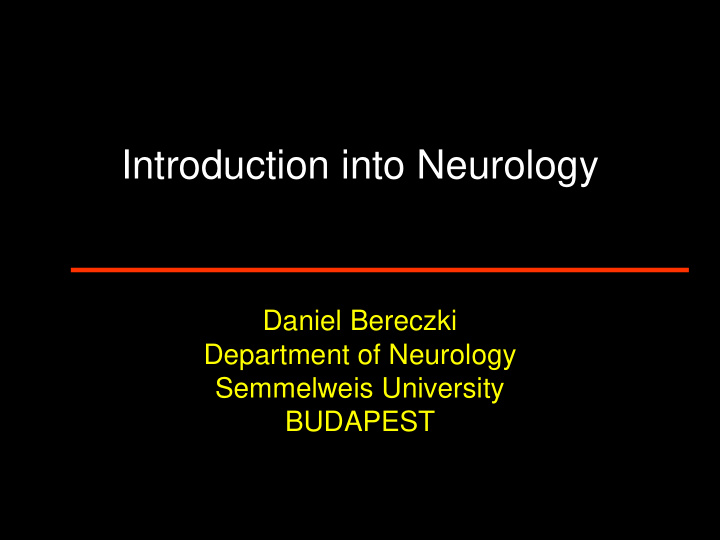



Introduction into Neurology Daniel Bereczki Department of Neurology Semmelweis University BUDAPEST
OUTLINE • Learning requirements – What to study – Practicals – Exams • Subject of neurology • The neurological diagnosis • Case presentations • Patient presentation
What to study? • Textbook: show what you have to the tutor of your group to see if it is OK, e.g. – Mumenthaler – Neurology Neurosurgery Illustrated, – Walton, Victor-Adams, Netter, etc • What is presented at the lectures • What you are taught at practical classes • Practical textbook of the Department • E-learning material of the Department
E-learning • Individual study • Interactive learning • Self assessment at the end of chapters • Use the same username and password as for other e-learning materials of Semmelweis University
E-learning www.semmelweiskiado.hu/
http://itc.semmelweis-univ.hu/moodle/
Exams • End of semester (first time in schoolyear 2007/2008 due to the credit system) – Practical exam (1-5) – Requirements: • What you learned on the practical classes • What you heared on classroom lectures • Departmental textbook • End of year exam – Practical exam – Written test in the e-learning system – Option to improve in oral exam
Neurology • Central nervous system – Brain – Spinal cord • Radices, plexus, nerves • Neuromuscular junction • Muscles
Borderzones • Internal medicine • Neurosurgery • Psychiatry • ENT • Ophthalmology • Urology • Dermatology • ETC
Tasks • To have in mind the possibility of a neurological disease based on – Anamnesis (history) – Physical exam • Diagnostic plan (decide on ancillary investigations) • Come to a diagnosis • Determine steps of treatment • Plan follow-up
Frequent neurological disorders • Cerebrovascular • Trauma disorders • Metabolic disorders • Tumors • Developmental • Epilepsy disorders • Multiple sclerosis • Inflammatory diseases • Parkinson syndrome • Neuropathies • Dementias • Chronic pain • Headache syndromes
Tasks in general practice • Take the history and perform exam. • Consider a neurological disease. • Answer the 4 questions. • Organize diagnostic procedures. • Decide on treatment. • Educate and help relatives of patient
Taking the hisory • Not enough time. • What exactly mean the patient and the relative on the complaint? • Do you suspect a neurological disease? • Is there an emergency?
What to consider at history • Age • Clarifying the symptoms • Mode of onset and progression • Chronological sequence of events • Value of negative information • Exclude irrelevancies • Drugs • Heteroanamnesis (interviewing relatives)
Problems with history • Time • Missing data • Misunderstandings „If a neurologist were in a group of people, stranded on a desert island, and if he were to be bereft of sight, arms and legs, but was still able to speak and hear, he would be able to take a history…… By the time the history is complete, the physician should be three-quarters of the way towards diagnosis, and, if he is not, then there is something wrong with the way in which it has been taken.” Bickerstaff ER
The neurological record of a patient • Personal data • History (taken from and by) • Internal exam • Neurological exam – Meningeal signs and signs of injury – Cranial nerves – Motor system – Sensory system – Reflexes – Co-ordination – Vegetative functions – Psychiatric condition • Summary • Opinion (probable diagnoses) • Diagnostic plan • Followup
The 4 questions to answer 1. Is there a neurological disease? 2. If yes, where is the lesion? 3. What pathological conditions may cause a lesion at this site? 4. In this patient which of these conditions is the most likely to be present?
If you suspect a neurological disease • Think over what to do with the patient. • Can you take the responsibility to treat this patient? • Is it necessary to send the patient to a neurologist? • How urgent it is?
Organizing the diagnostic procedures • Is it an emergency? • If yes, where to send the patient? • If not, how far can I get in the diagnostic process? • What ancillary investigations to ask for, and from whom? • Where do they perfom these investigations? • If the appointment is at a distant time, is it safe to wait?
Organizing the care of the patient • I reached the diagnosis myself or with a help of a specialist. • Who determines the therapy? • Is there a need for pharmacological or other treatments? • Who may prescribe certain drugs? • Shall I prescribe original or generic drugs? • How frequently shall I check the patient? • What to do during checkup exams? • When shall I send back the patient to a neurologist? • Shall I send to an outpatient service or to hospital?
Education of relatives • Is it needed to involve relatives – When taking history? – When deciding on treatment options? – When organizing long term care? • Pick the proper person from the relatives. • Keeping contact with the relatives.
Ancillary invstigations to confirm or refute the suspected diagnosis • Methods examining structure – X-ray, CT, MRI, ultrasound • Imaging methods examining function – fMRI, SPECT, PET, ultrasound • Electrophysiological methods – EEG, ENG, EMG, evoked responses • Examination of the cerebrospinal fluid • Immunological, genetic and molecular biological investigations • Cytology and pathological investigations • Consultations with other specialities
Old methods (until mid 80-ies) 1. day: cisternali CSF sampling 2. day: percutaneous carotid angiography
PNEUMOENCEPHALOGRAM MR IMAGING
Intracerebral hemorrhage
Arteria cerebri anterior
Carotid Ultrasound
Transcranial Doppler
Visual evoked response
Prolonged migraine aura Delta
CSF examination
Pathology ISCHEMIC STROKE INTRACEREBRAL HEMORRHAGE Hegedűs, 2001
http://www.aan.com
Recommend
More recommend